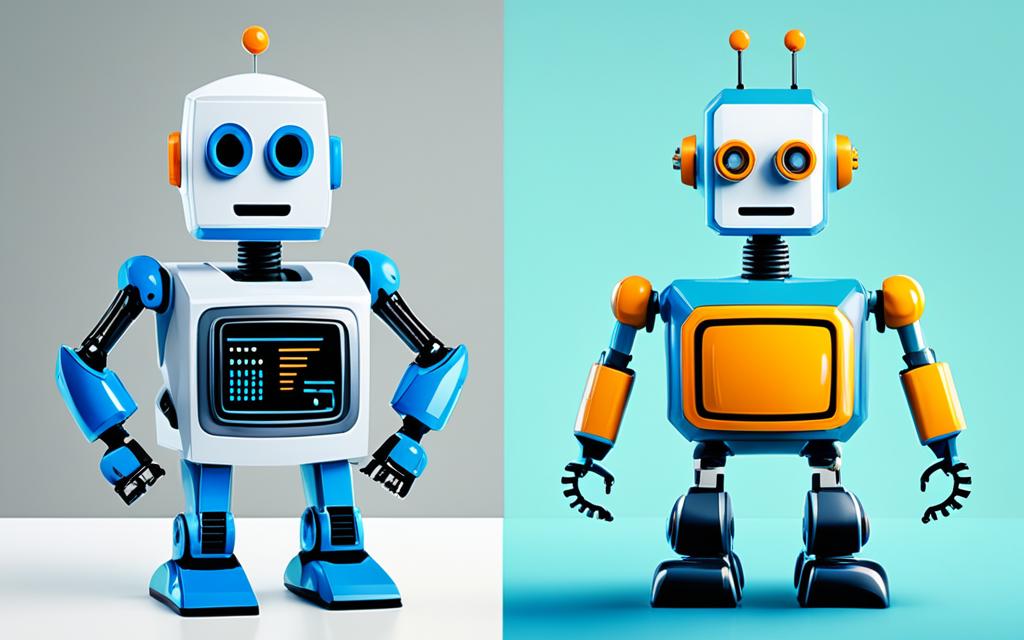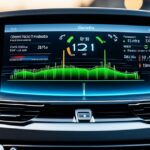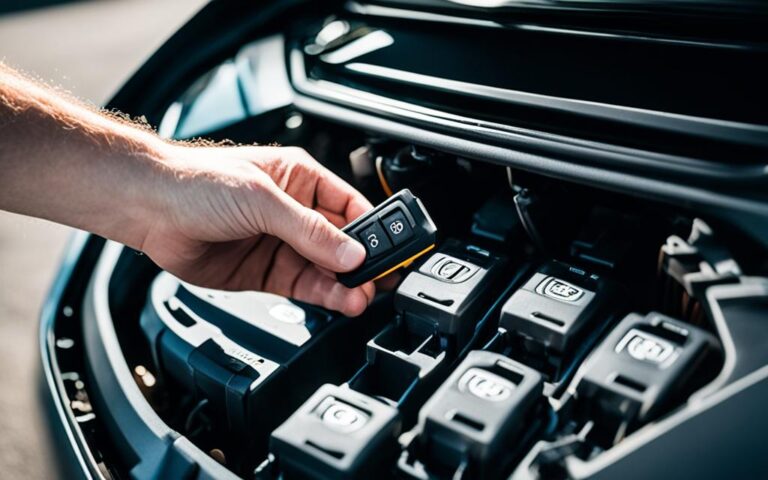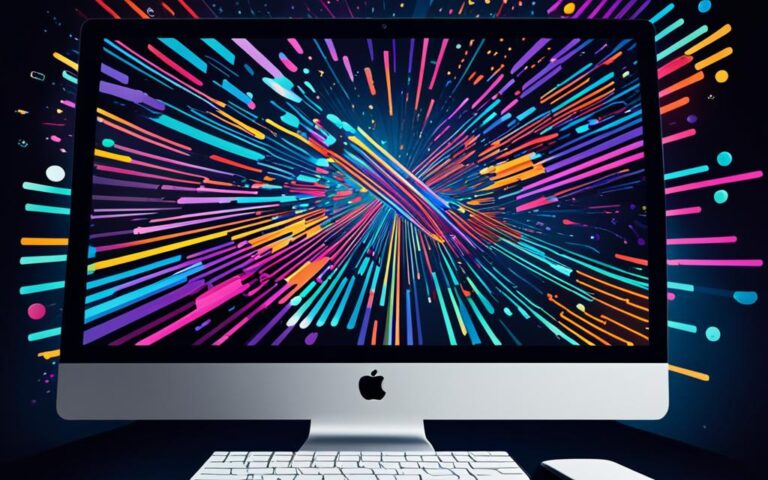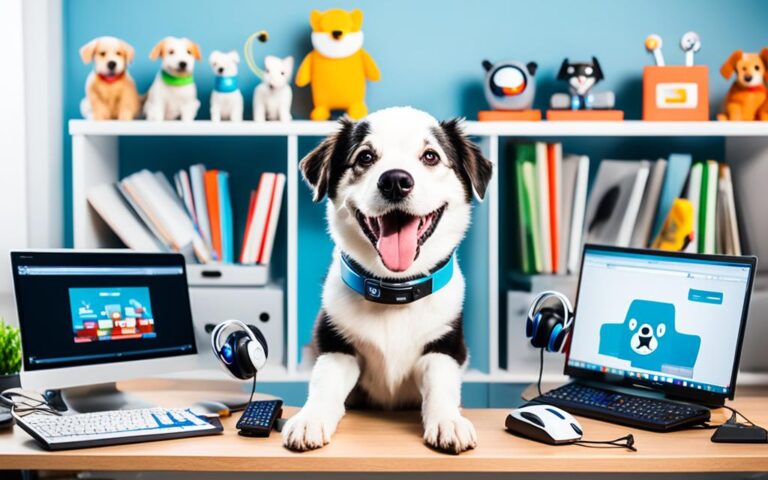Robots and computers are often mixed up, but they are quite different. Computers do specific tasks, while robots work on their own. Robots can do complex tasks by themselves, but computers need a person to help them. Knowing the difference is key in our automated world.
Key Takeaways:
- Robots are machines capable of autonomous operation, while computers require human intervention.
- Robots can be programmed to carry out complex tasks independently.
- Computers are devices that perform specific tasks.
- Understanding the difference between robots and computers is crucial in the era of increasing automation.
Robots and computers have different roles in today’s tech world. Computers handle tasks like data processing. Robots, however, can work on their own. They can do complex tasks without needing a person to tell them what to do.
For example, if two robots try to use the same computer license, it can cause problems1. To fix this, robots can wait until they’re free to start their tasks. This helps use resources better, especially with many users1.
Computers need people to tell them what to do. They’re great at doing complex tasks fast. But they can’t work on their own like robots do. Still, computers help control and program robots, giving them the power to work.
Knowing the difference between robots and computers is vital as we use more automation. Robots are changing many fields like manufacturing and healthcare. They can do tasks that are dangerous or need a lot of work. From the fastest robot to the first one used in factories, robots are making a big impact2. But, there are worries about robots taking jobs and being used in war2.
Robots can act like humans in some ways, but they’re not the same. The Turing test tries to tell if a machine is smart like a human. It says that being kind is what makes us different from computers3. Machines can pretend to feel emotions, but it’s hard to make them truly care like humans do3. Feeling for others is important for machines to show kindness3. Humans without empathy are like robots, showing why these traits matter3.
In conclusion, robots and computers are very different in today’s automated world. Computers do tasks with human help, while robots work alone. Understanding these differences helps us use robots well and think about their impact. As we move forward, working together with machines will help us make progress that improves our lives.
What is a Machine?
A machine is a device that does specific tasks or functions4. They can be mechanical, electrical, or electronic. Machines make work easier and more efficient for us. They automate processes and reduce the effort needed in many areas.
When we think of machines, we might imagine complex industrial gear or advanced electronic gadgets. But machines vary greatly in size and purpose. From simple tools like hammers and wrenches to complex cars and computers, they help us do tasks better and faster.
In transportation, we have bikes, cars, planes, and trains for quick and easy travel. At home, machines like dishwashers, washing machines, and vacuum cleaners make cleaning easier. Our computers are also machines that let us process information, communicate, and access many services5.
Some machines need us to control them, like a bicycle. Others, like cars, can be driven manually or automatically. Industrial robots are an example of machines that work on their own, doing repetitive tasks with great precision5.
Machines play a big role in our daily lives, changing how we work, communicate, travel, and do tasks. They’ve evolved with technology, helping us progress and develop as a society.
But machines and robots are not the same thing. Machines are made for specific tasks, while robots can do many things and work on their own. Knowing the difference helps us understand the potential of these technologies6.
Next, we’ll look at robots and their unique abilities and uses in different industries.
What is a Robot?
A robot is a machine that can do complex tasks on its own. It works without needing a human to tell it what to do. Robots vary in size and shape. They can be set to do things like make cars, explore space, or cook food.
There are two main kinds of robots. First, industrial robots work in places like factories. They do tasks like welding, painting, or putting parts together7.
Second, service robots help people and interact with them. They’re used in healthcare, hotels, and homes. These robots can clean, cook, or help people with disabilities7.
Robots are smarter than machines. They can understand data, make choices, and change their actions. Machines just follow what they’re told7.
Industrial robots make factories work better by moving heavy things fast and accurately8.
Robots could become more like us as artificial intelligence grows. This means they might get smarter and more flexible97.
But robots are not the same as computers. Computers are smart, but robots can move and change their surroundings9.
Robots don’t feel emotions like humans do. But they can act like they do in certain situations. This is useful when they talk to people, like in shops or hospitals97.
Robots help make things automated. They do tasks in many industries, making things more efficient and boosting productivity9.
In summary, robots are machines that can do complex tasks by themselves. They have different types, like industrial and service robots, each for a specific job. With AI, robots are getting smarter and more useful. They help in many areas by working with people and automating tasks97.
Autonomy and Human Intervention
When we talk about robots and machines, it’s important to look at how much they can do on their own. Machines need people to work them and tell them what to do. Robots, however, can do many things by themselves. They don’t always need people to tell them what to do, making them more independent.
This independence comes from using robotics and artificial intelligence (AI) together. Robotics helps make machines that can do tasks automatically. AI lets machines think and learn like humans, so they can make decisions and change how they act.
By combining these technologies, robots can work with little or no help from people. They can move around, touch things, and do tasks well. They use sensors to see and understand their world, then act based on what they learn.
In places like factories and hospitals, robots are used a lot for tasks that need to be done the same way every time10. AI helps with things like sorting data and designing algorithms in many areas10. Together, these technologies make robots do tasks better and faster, which helps people make smarter choices by giving them useful information10.
Collaborative robots, or cobots, are a great example of how robots and people can work together. Cobots are used in many areas for tasks that are too hard or need extra strength, like moving heavy things or doing tricky tasks10. They work with people, making things safer and helping people do their jobs better. This shows how robots and people can work together to get better results.
The Safety Challenge of Autonomous Decision-Making
Robots being able to make decisions on their own is good in many ways, but it also brings challenges. Using AI in robots means we have to be careful and sometimes have people watch over them to avoid problems and keep people safe10.
As robots get more independent, we need to make sure they make safe choices. This means making sure AI is used responsibly, thinking about privacy and safety10. We need to have plans for when things don’t go as expected, like in self-driving cars or during medical procedures.
| Statistical Data | Reference |
|---|---|
| Approximately 800 million jobs globally may be replaced by robots in the future, rendering about 30% of all occupations irrelevant11. | 11 |
| Only 7% of businesses currently do not use AI but are considering its implementation11. | 11 |
| Experts in robotics and AI typically have backgrounds in computer science, physics, or engineering10. | 10 |
Complexity and Intelligence
In robotics and artificial intelligence (AI), there’s a clear difference between robots and machines. Robots and machines have different skills and roles. They serve various purposes.
Robots are machines that can act on their own or partly on their own12. They are made to do complex tasks that need thinking. They can look at data, make choices, and adjust to new situations12.
Machines, however, do tasks set by humans. They might be very good at what they do but can’t learn or change for new situations12. They are made for simpler tasks and don’t have the same complexity as robots12.
Artificial intelligence (AI) aims to make programs that can do tasks that humans do12. AI is used in many things like Google searches, Amazon’s suggestions, and SatNav12. But, many AI programs don’t work with robots directly. They are used in different areas12. Old industrial robots did the same thing over and over without AI12.
The mix of robotics and AI has led to smart robots. These robots have the skills of both robotics and AI. They can do complex tasks on their own12. They work by themselves and use smart AI to handle tough tasks, change with new situations, and make decisions12.
| Complexity of Robots | Intelligence of Machines |
|---|---|
| Designed to perform complex tasks | Execute tasks based on pre-programmed instructions |
| Capable of autonomous or semi-autonomous actions | Lack the ability to learn or adapt to new situations |
| Analyze data, make decisions, and adapt to changes | Perform simpler tasks without cognitive abilities |
| Utilized in various industries and applications | Extensively used for specific purposes |
Mobility and Interaction
Machines usually stay in one place or move a bit. Robots, however, can move in many directions and go through different places easily13. For example, space robots can move on the moon or other planets, showing how well they can move.
Robots also talk to humans in ways machines can’t13. In the hospitality field, these robots help guests, take orders, suggest things, and make eating out better. They move around the restaurant to talk to customers and meet their needs.
Robots also have special features to talk to humans better. AI chatbots are now common in customer service, answering simple questions on their own13. These chatbots give quick and helpful support, making things easier for customers.
In the aerospace industry, AI helps robots work better and more efficiently in making parts13. Robots use AI to fix their path in real time, making their work precise. This helps in many ways.
AI also makes packaging better by making robots work smarter and cheaper13. Robots can now pack things with great precision and speed, making things more efficient in many areas.
Robots with advanced AI can see better and recognize images, which is key in assembly and logistics13. They can spot and understand objects, making things run smoother and better.
Machine learning helps robots get smarter and better at doing tasks, from home helpers to factory robots13. Robots learn and adapt, making them move through tough places and do tasks well.
Education and Training for Robotics Engineers
To be a top robotics engineer, you usually need a degree in computer engineering, computer science, or electrical engineering13. These courses teach engineers how to make robots that move and interact well.
The Future of Robotics
Adding Artificial General Intelligence (AGI) to robots is the next big step in AI13. For robots to really understand like humans, they need to be super mobile and smart. As scientists work on making robots better, we can expect huge changes in many areas.
Applications of Robots and Machines
Robots and machines are changing many industries, making tasks easier and more efficient. They bring new possibilities and change many sectors. Let’s look at some key uses of robots and machines.
1. Manufacturing
In manufacturing, robots help with tasks like welding, painting, and packaging14. They work with great precision, making production faster and improving quality14. Robots take over repetitive or hard tasks, making work safer and more efficient for people.
2. Healthcare
Robots are making a big difference in healthcare. They help surgeons be more precise during complex operations14. They also aid in rehab and monitor patients, giving doctors important data15. This has led to better care and outcomes for patients.
3. Agriculture
In farming, robots do tasks like planting and harvesting14. They make farming more efficient and save money14. This helps farmers produce more and rely less on people, solving labor issues and cutting costs.
4. Space Exploration
Robots are key in space exploration. They explore planets, run experiments, and gather data in tough places14. They also fix satellites, helping space missions last longer14. These robots help us learn more about space and prepare for future missions.
5. Hospitality and Service Industries
Robots are helping in the service industry too. They work in hotels, malls, and banks, offering info and services14. They make things run smoother, cut down on wait times, and let people focus on helping customers more.
6. Collaborative Robotics
Collaborative robots, or cobots, are becoming more common. They work with people, doing tasks that need both human and robot skills16. Cobots are easy to use and fit into many work settings16. They’re great for small businesses needing flexible automation.
Robots and machines are changing many industries. They bring better efficiency, precision, and safety. Using these technologies is key for businesses to stay ahead in our fast-changing world.
Evolution and History
Robots and machines have changed a lot over time, changing how we live and work. Learning about their evolution and history helps us understand their growth and impact on society.
Evolution of Machines
Machines have been key to our lives since ancient times. In the 18th century, automation started during the first industrial revolution. The spinning jenny and power loom made spinning and weaving faster, changing the textile industry17. Later, the 19th century saw machines like the steam hammer and Bessemer converter improve automation even more17.
Henry Ford’s assembly line in the early 1900s changed how things were made, making production faster and more efficient17. By the mid-20th century, machines got even smarter with programmable controllers and electronic technology17. Now, robots are used in many industries, showing how important they are in making things today17.
The Birth of Robots and Artificial Intelligence
The word “robot” was first used in 1921 in a play called “RUR” by Karel Čapek18. The study of artificial intelligence started in the 1940s and 1950s. Scientists like Warren McCulloch and Walter Pitts worked on neural networks, and Alan Turing came up with the Turing test18. Alan Asimov’s “Three Laws of Robotics” in 1950 helped guide how robots should behave18.
The Dartmouth Summer Research Project on Artificial Intelligence in 1954 was a big step forward for AI research18. John McCarthy named the field “artificial intelligence” at the Dartmouth conference in 1956, making it clear how important it was18.
Merging Paths: Machines and Artificial Intelligence
Over time, machines and artificial intelligence have become more connected. Advances in both areas have made robots and machines do more. Since the 1950s, computers have been key to AI progress19. The 1990s and 2000s saw big steps forward, like speech recognition software from Dragon Systems19.
Moore’s Law has helped AI grow, with computers getting faster and more powerful every year19. This led to big wins, like IBM’s Deep Blue beating Gary Kasparov in chess and Google’s Alpha Go winning against Ke Jie19. AI is now used in many areas, like tech, banking, marketing, and entertainment, making use of big data and computing power19. AI’s language processing is also getting better, making it easier for humans and machines to talk and translate in real-time19.
| Robots | Artificial Intelligence |
|---|---|
| Automated tasks in industries | Revolutionized decision-making processes |
| Precision, efficiency, and speed | Processing vast amounts of information |
| Surge in industrial automation | Improvements in language processing |
Robots and artificial intelligence are closely linked. As machines get smarter, the line between them and AI gets blurry. AI is pushing forward automation, opening up new possibilities and potential. Robots and machines have come a long way, but the goal of making machines smarter than humans is still a challenge1918.
Collaboration and Advancements
The teaming up of robots and humans, thanks to AI progress, is changing many industries. It’s making big steps forward in different areas. This mix of computer science and robotics leads to new discoveries and big changes.
Cobots work with humans, using their skills to make work safer and more efficient. They help with tasks that need human skills and effort. This is changing industries by making humans and robots work together better.
Industry 4.0 shows how robotics and computer science are changing work in smart factories. They’re improving production, quality, and how things work together20. In healthcare, surgical robots are doing precise, less invasive surgeries20. This mix of tech is changing how we care for patients and help them recover20.
Robots are also going to space, exploring hard places and sending back important data20. They’re changing healthcare worldwide, from finding problems to treating them20. These changes could greatly improve life for people everywhere.
“The emergence of collaborative robots, or cobots, has significantly influenced industries, primarily due to their security, ease of use, and affordability.”
Cobots are becoming popular in small and medium businesses for their easy setup and use21. They’re different from other robots because they work with humans, changing how we interact with robots21. Cobots can do many tasks, like taking parts out of molds and checking quality with computer vision21. More companies are using cobots, making their work better and more efficient21.
But, there are also big questions about using AI and robots. We need to think about how they affect jobs and keep them safe20. As technology gets better, robots might understand us better, leading to more human-like interactions20.
Robots and humans working together opens up new possibilities. AI is making us better at what we do, driving new ideas, and changing industries worldwide. This teamwork is key to making a better world for everyone.
| Advancements in AI and Robotics | Statistics |
|---|---|
| Industry 4.0 impact on production, quality control, and operational efficiency | Reference20 |
| Surgical robots enabling minimally invasive procedures in healthcare | Reference20 |
| Robotic exoskeletons facilitating physical rehabilitation | Reference20 |
| Collaboration between computer science and robotics in space exploration | Reference20 |
| Integration of computer vision, machine learning, and robotics in healthcare | Reference20 |
| Ethical considerations in the development of computer science and robotics | Reference20 |
| Collaborative robots (cobots) in industries | Reference21 |
Conclusion
Knowing the difference between robots and machines is key in today’s automated world. Machines do specific tasks and need humans to help, while robots can act on their own, think for themselves, move, and talk22. Robots are not just about doing things fast; they can make decisions and change how they work22. Over the past 20 years, robotics and AI have grown fast, changing many areas like making things, health, and business22. Robots and humans working together, thanks to AI, could change many industries, making things better and more efficient22. Robots help in surgeries, make healthcare better, and help understand diseases like cancer22. In business, robots make things faster and with fewer mistakes, making tasks easier22. Robotics and AI aim to make life better, solve big problems, automate boring tasks, understand nature, and create a fairer world22.
AI systems are great at learning from data and getting better over time. They do well in changing situations, adapting to new problems, and making smart choices based on data patterns23. Unlike traditional computers, AI can think and learn like humans23. The future might see AI and regular computing work together, making software smarter and more helpful23. But, we need to think about the ethical side of AI, like bias, job loss, privacy, and making AI decisions responsibly23.
In the end, robots and machines are different in how they work on their own, think, move, and interact. Robots make decisions by themselves, while machines need us to help22. Working together, robots and humans, with AI’s help, could change many areas, making things better and improving life22. As technology gets better, we face new chances and challenges. It’s important to move forward with AI responsibly and ethically23. By understanding these differences and using them well, we can look forward to a brighter future where robots and AI lead progress and solve big problems22.
FAQ
What are the differences between a robot and a computer?
Robots can work on their own and do complex tasks by themselves. Computers do specific tasks but need a person to help them.
What is a machine?
A machine is a device that does certain tasks. It can be mechanical, electrical, or electronic. Machines make work easier and faster for us. Examples include hammers, bicycles, cars, dishwashers, and computers.
What is a robot?
A robot is a machine that can do complex tasks by itself. It can move and work without a person telling it what to do. Robots can do things like make cars, explore space, or cook food.
How are robots different from machines?
Robots work by themselves, while machines need a person to control them. Robots can do complex tasks that need thinking, while machines do simpler tasks.
What are the differences in terms of mobility and interaction?
Robots can move around and go into different places, making them more mobile than machines. Robots also talk and work with people, but machines don’t.
What are the applications of robots and machines?
Robots are used in many areas like making things, helping in healthcare, and serving in hotels. They can weld, paint, clean, cook, and help people with disabilities. Machines do everything from washing dishes to processing computers.
Can you provide some information about the evolution and history of robots and machines?
Robots have changed a lot over time, getting better in design and what they can do. Machines have been around for a long time, getting more efficient and diverse thanks to new technology. The word “robot” was first used in 1921, and artificial intelligence started in 1956.
What is the collaboration between humans and robots called?
Working together with robots is called cobots or collaborative robots. Cobots are made to do tasks that need human skills and effort. Robots can now talk smartly with humans and other robots thanks to artificial intelligence.
Why is it important to understand the differences between robots and machines?
Knowing the differences helps us use automation well today. Machines need people to help them, but robots can work by themselves. They are smarter, move around, and talk to people. Understanding this helps us use robots and machines in many industries.
Can you summarize the differences between robots and machines?
Machines need people to work and do simple tasks. Robots work on their own and are smarter, move around, and talk. Working together with robots and people, thanks to smart technology, can make things more efficient and productive in many areas.
Source Links
- https://forum.uipath.com/t/2-users-sharing-1-license-on-1-computer/222288 – 2 users sharing 1 license on 1 computer
- https://en.wikipedia.org/wiki/Robot – Robot
- https://www.thedeepthinker.com/blog/the-only-difference-between-humans-and-robots – The Only Difference Between Humans and Robots — The Deep Thinker
- https://www.otomasyonavm.com/en/what-is-the-difference-between-a-robot-and-a-machine – What is the difference between a robot and a machine?
- https://topupagency.com/tech/difference-between-computer-and-robot/ – Difference Between Computer and Robot | Computer vs Robot
- https://recfaces.com/articles/computer-vision-vs-machine-vision – Machine (Robot) Vision vs Computer Vision Technology — RecFaces
- https://www.devopsschool.com/blog/what-is-the-difference-between-a-robot-and-a-machine/ – What is the difference between a robot and a machine? – DevOpsSchool.com
- https://builtin.com/robotics – Robotics: What Are Robots? Robotics Definition & Uses.
- https://www.computerhope.com/jargon/r/robot.htm – What is a Robot?
- https://www.telefonica.com/en/communication-room/blog/difference-robotics-ai/ – Differences between robotics and Artificial Intelligence
- https://www.forbes.com/sites/naveenjoshi/2022/01/16/3-key-differences-between-ai-and-robotics/ – 3 Key Differences Between AI And Robotics
- https://nanduribalajee.medium.com/robotics-vs-artificial-intelligence-what-is-the-difference-6adad236d997 – Robotics Vs. Artificial Intelligence: What is the difference?
- https://onlinedegrees.sandiego.edu/application-of-ai-in-robotics/ – Applications of AI in Robots: An Introduction
- https://www.electronicsforu.com/tech-zone/tech-of-robotics/robotics-types-applications – What is Robotics? Its Types, Applications, and Future
- https://www.lenovo.com/us/en/glossary/what-is-a-robot/ – How can robots benefit from cloud computing? Are all Robots Autonomous?
- https://www.universal-robots.com/fi/blogi/understanding-the-differences-between-robotics-and-automation/ – Understanding the differences between robotics and automation
- https://www.firgelliauto.com/blogs/actuators/what-is-the-evolution-and-history-of-automation – What is the evolution and history of Automation?
- https://alltechmagazine.com/the-evolution-of-ai/ – The History And Evolution Of Artificial Intelligence
- https://sitn.hms.harvard.edu/flash/2017/history-artificial-intelligence/ – The History of Artificial Intelligence – Science in the News
- https://leyton.com/ca/insights/articles/the-dynamic-relationship-between-computer-science-and-robotics – The dynamic relationship between computing and robotics – Leyton
- https://atriainnovation.com/en/blog/use-a-collaborative-robot – Why using a collaborative robot? – ATRIA Innovation
- https://www.forbes.com/sites/forbestechcouncil/2022/05/31/why-robotics-and-artificial-intelligence-are-the-future-of-mankind/ – Council Post: Why Robotics And Artificial Intelligence Are The Future Of Mankind
- https://www.rigb.org/explore-science/explore/blog/whats-difference-between-ai-and-regular-computing – What’s the Difference Between AI and Regular Computing?
